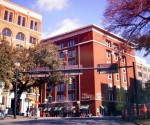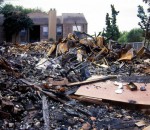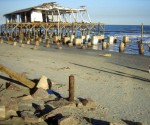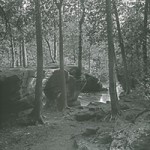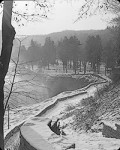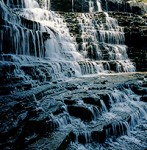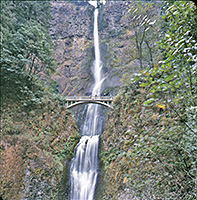
Category Archives: a22
…and the Clock Struck KAZAM! #2
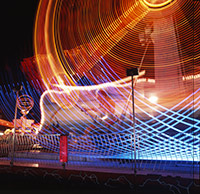
Carnival rides light up the Puyallup Fair at night
I have my night exposures of carnival rides pretty well set, but this particular ride was running without the spotlights for most of the duration of the ride. It looked darker than usual, so I bumped the exposure. Taken with twin Hasselblad 500Cs, 50 mm lenses. Exposure could have been 16 seconds at f22.
The top part of the ride is swinging down, and looks to me like the pendulum on a clock. It intersects with Sinbad’s extended sword in the painted backdrop. It looks as though he’s hitting the pendulum with a loud KAZAM!
Canyon X Colors #34
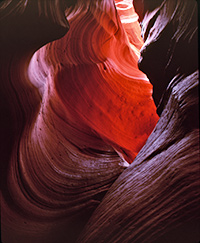
Reflected, unfiltered light in Canyon X
Last year I was on a break between contracts, and Mandy saw a window of opportunity to sneak off for a vacation. Picking the southwest US was easy. She had only 2 weeks available, but I was free as a bird, so I offered to drive down to Page Arizona a week early. That gave me a few days to spend with a photo guide, Mandy flew down to meet me, and we took it from there. I’ve seen shots of Antelope Canyon for years, but I had no idea what a tourist trap the place has become. When I went to Antelope, which is a fairly short Canyon, there were 200 other photographers crammed into this tiny space elbow to elbow.
I also went to Canyon X, which only one tour company has the rights to visit, and it was a completely different scene. Unfortunately, most of the day at Canyon X we were getting filtered light, but there were some lucky breaks, like this one. It’s all reflected light bouncing around. There’s no surface in this shot getting direct sunlight. I metered off the highlights.
I think this makes a nice complement to John’s ice cave.
Above Lake Viviane
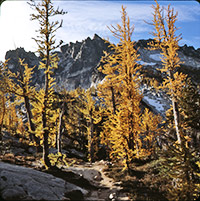
Golden larch in the Alpine Lakes Wilderness, Washington
Mandy and I went on a backpacking trip into the Alpine Lakes Wilderness in September 2007. Permit required, hard hiking, heavy pack, uncooperative weather. The whole point for me was photography, and by 3 days in I had taken 1 stereo pair in 35mm. Winds died down some on the 4th day and I went nuts with the picture taking. This area is known for its pristine lakes, granite peaks, and larch turning gold in the fall. It’s a stunningly beautiful place.
This was taken with my Sputnik, tuned up by Don Lopp. Thank you, Don! Please forgive any mounting errors — the focal lengths of the lenses are a little mismatched.
Tornado Bubble #10
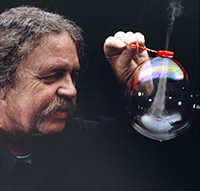
Tom Noddy and the Tornado Bubble
In the last loop, I included a shot of my friend Tom Noddy with one of his marvelous bubbles. That was shot with the TL-120 and some bounce flash, but when I tried to figure out the exposure, I made some gross errors. So why did the pictures come out okay? I apparently made a whole bunch more errors in making my settings. Yes, I’m an idiot. But I’m an extremely lucky idiot.
This year I did some test shots before inviting Tom over again. There’s black velvet hung behind, because the DOF is extremely shallow. I think we had sharpness between about 28 and 32 inches. I had several flash units triggered by slaves, mostly bouncing off the ceiling here. (I’ve been reading the strobist blog a lot lately, and trying to learn more about the use of flash.)
To create this, Tom blows a bubble and catches it on the wand. He blows a second bubble below it, filled with smoke, so the smaller smoke bubble is attached and hanging below the clear bubble. Tom sticks a wet straw through the wall of the top bubble and blows gently, so the air is swirling inside. Then he break the membrane between the 2 bubbles, so now the smoke is inside the bubble with the swirling air, and the smoke is still somewhat concentrated. Finally, he opens a hole in top of the bubble, so the bubble deflates like a balloon, forcing out the swirling smoke. I shot a bunch of these. Every time you shoot one, you watch what it continues to do, and you think, “Dang! It got even better after I fired!”
I like the detail of the swirling smoke, and the saturated colors on the top of the bubble.
Sixth floor museum Dealy Plaza Dallas
This was taken with the Don Lopp tuned up sputnik. Shot on 1-3-09. The colors look off to me, too much magenta. The depository is the left hand building. The 6th floor window is one floor below the top of the structure. The window that Lee Harvey Oswald allegedly shot from is the square shape window to the right of the row of arched windows.
Constructed in 1901, the red brick building on the corner of Houston and Elm streets was known as the Texas School Book Depository at the time of the assassination of President John F. Kennedy. The private firm stocked and distributed textbooks for public schools in north Texas and parts of Oklahoma.
Following the Kennedy assassination, the building became the focus of shock, grief and outrage. Evidence was found showing that shots were fired from the sixth floor, and Depository employee Lee Harvey Oswald was charged with the president’s murder.
Hurricane Ike Meadow Chase Apartments
aftermath
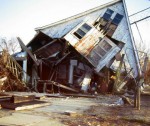 Hurricane Ike was the third most destructive hurricane to ever make landfall in the United States. This photo was taken on Bolivar Peninsula in December 2008. It is actually one of the few structures that wasn’t totally washed away. The camera used was the TL120.
Hurricane Ike was the third most destructive hurricane to ever make landfall in the United States. This photo was taken on Bolivar Peninsula in December 2008. It is actually one of the few structures that wasn’t totally washed away. The camera used was the TL120.
Here is a link with more photos in 2d: http://www.boston.com/bigpicture/2008/09/the_short_but_eventful_life_of.html
Remains of Balinese Ballroom Galveston
Hurricane Ike roared through Texas on September 13, 2008. Its path of destruction included Galveston Island and Bolivar Peninsula and Houston. Bolivar was nearly flattened, few structures remain. The Ballinese Ballroom was a Galveston landmark. Frank Sinatra even performed here! Here is a link to this famous ballroom built in the 1920’s: http://balineseroom.net/historyofBalinese.htm
The TL120 was used for this shot.
The work of James Mutch, June 2009
The work of Matt Neima, June 2009
Palm Tree Lane , Hyères, France
On the south coast of France in the middle is Hyères near Toulon. Shot with a Sputnik.
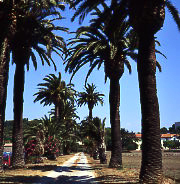
Lac Léman, Geneva, Switzerland
Chamois cave, overlooking Geneva
This cave is on a path high over the city of Geneva. As we entered a bunch of small chamois goats scooted out. Sputnik shot in 2001.
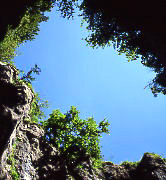
Notre Dame de Bonsecours
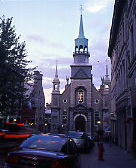
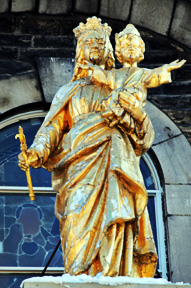 In old Montreal, photographed using two Mamiya C-330 cameras with 65 mm. lenses on a Manfrotto tripod. I used a twin cable release to trip the shutters in near synch. Notre-Dame-de-Bon-Secours (“Our Lady of Good Help”) Chapel, a church in the district of Old Montreal. One of the oldest churches in Montreal, it was built in 1771 over the ruins of an earlier chapel. In 1849, Mgr. Ignace Bourget, Bishop of Montreal, gave the chapel a statue of the Virgin as Star of the Sea, which was placed atop the church overlooking the harbor. In the 19th century, the chapel came to be a pilgrimage site for the sailors who arrived in the Old Port of Montreal; they would make offerings to the Virgin in gratitude for her “good help” for safe sea voyages.
In old Montreal, photographed using two Mamiya C-330 cameras with 65 mm. lenses on a Manfrotto tripod. I used a twin cable release to trip the shutters in near synch. Notre-Dame-de-Bon-Secours (“Our Lady of Good Help”) Chapel, a church in the district of Old Montreal. One of the oldest churches in Montreal, it was built in 1771 over the ruins of an earlier chapel. In 1849, Mgr. Ignace Bourget, Bishop of Montreal, gave the chapel a statue of the Virgin as Star of the Sea, which was placed atop the church overlooking the harbor. In the 19th century, the chapel came to be a pilgrimage site for the sailors who arrived in the Old Port of Montreal; they would make offerings to the Virgin in gratitude for her “good help” for safe sea voyages.
The close-up on this page was taken with a NikonD300 with a 55-200 mm VR lens. f-8 200 mm 1/250 sec.
